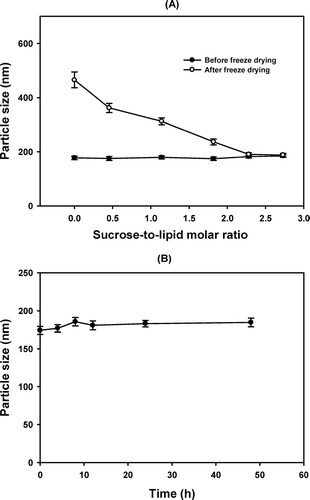Figures & data
FIG. 1 The effect of CH-to-lipid molar ratio on (A) the entrapment efficiency (%) of paclitaxel in the liposomes and (B) the changes of the mean particle size of liposome containing 10% cholesterol (molar percent to lipid). The liposomes were prepared using 5.4% (w/v) S100PC with various CH-to-lipid molar ratio of cholesterol. The amount of paclitaxel loaded in the formulation was 0.6 mg/mL, and the hydration medium was PBS (pH 4.0) containing 3.0% (v/v) of Tween 80.

TABLE 1 Effect of lipid and paclitaxel contents on the entrapment of paclitaxel in the liposome
FIG. 2 Effect of lipid types on the entrapment efficiency (%) of paclitaxel and paclitaxel content in liposome (%). The liposomes were prepared using 10% (w/v) of various lipids with cholesterol (CH-to-lipid molar ratio = 10:90) and were loaded with 3.5 mg/mL paclitaxel (lipid-to-paclitaxel molar ratio is 32.6). The hydration medium was PBS (pH 4.0) containing 3.0% (v/v) of Tween 80.

TABLE 2 Effect of PEG 400 on the entrapment of paclitaxel in the liposome
FIG. 3 (A) Effect of sucrose on the change of the mean particle size of liposome before (•) and after (ˆ) freeze drying. The liposomes were prepared using 10%% (w/v) of S100PC with cholesterol (CH-to-lipid molar ratio = 10:90) and were loaded with 3.5 mg/mL paclitaxel. The hydration medium was PBS (pH 4.0) containing 3.0% (v/v) Tween 80 and 5% (v/v) PEG 400. Liposome particles were separated by ultrafiltration and were suspended with distilled water containing various concentrations (molar ratio to lipid) of sucrose before freeze drying. (B) Change of particle size of liposome containing sucrose as a lyoprotectant (sugar-to-lipid molar ratio = 2.3) at room temperature when freeze-dried liposome powder was reconstituted with 0.9% (w/v) NaCl solution.

TABLE 3 Cytotoxicity of paclitaxel in 1:1 blend of Cremophor® EL and ethanol (Taxol®) and in various liposome formulations against MDA-MB-231 human breast cancer cells after 24 h incubation